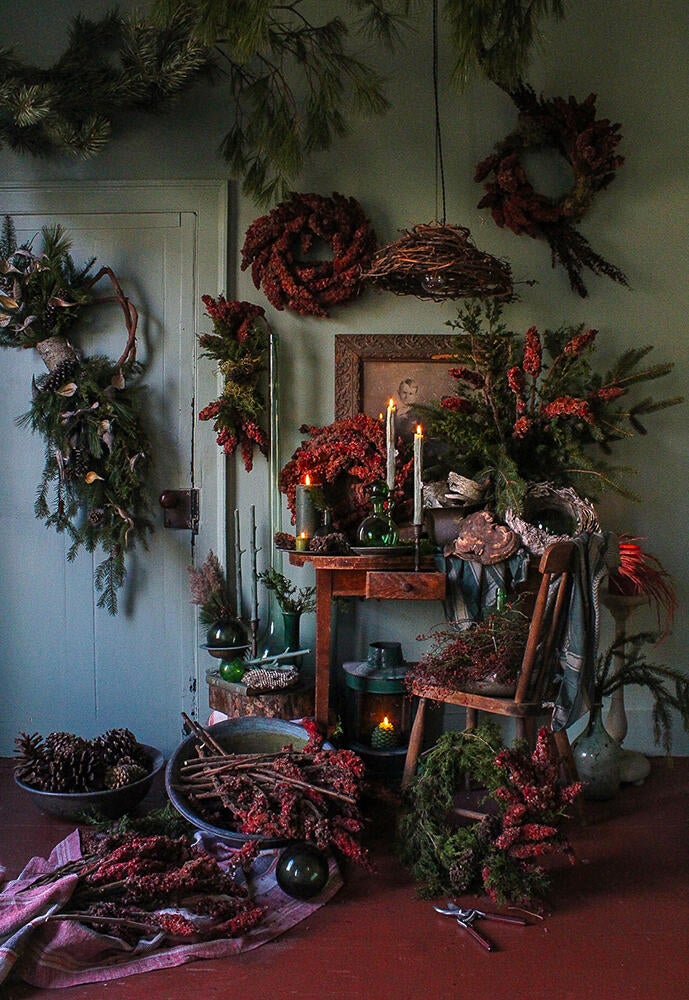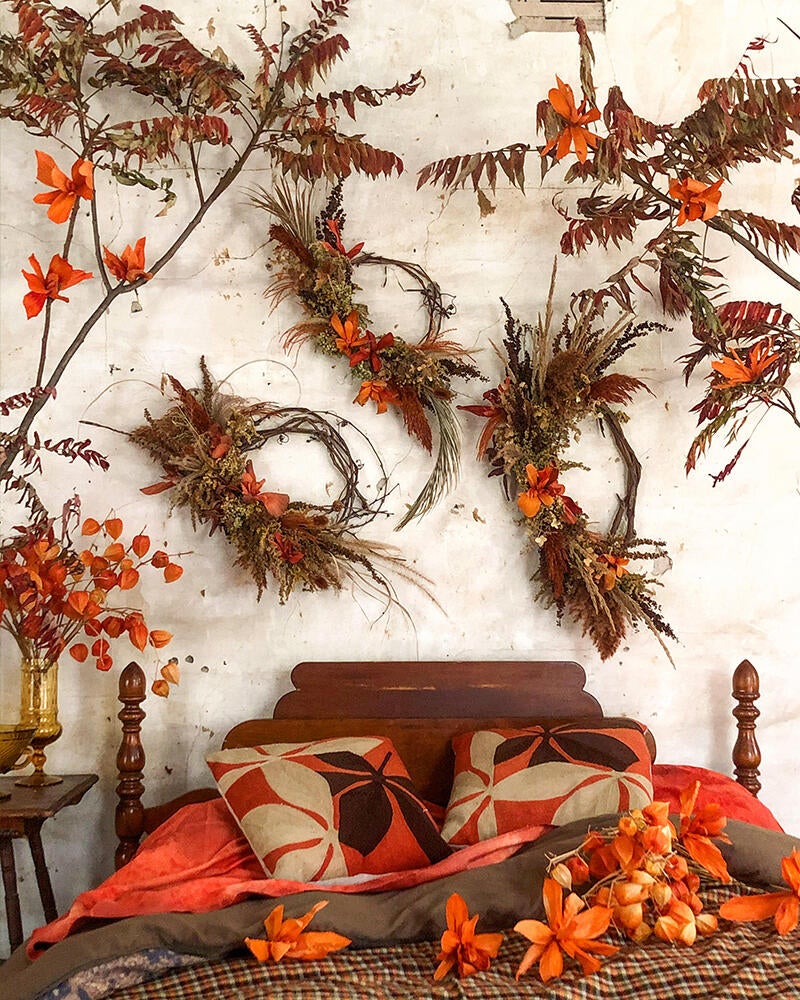In Business of Home’s series Shop Talk, we chat with owners of home furnishings stores across the country to hear about their hard-won lessons and challenges, big and small. This week, we spoke with Todd Carr and Carter Harrington of Hort and Pott in upstate New York.
The botanical shop has had a few iterations over the years. It began as a series of pop-ups across Maine by Carr, a garden designer and gardening editor, and transformed into a brick-and-mortar spot in Oak Hill, New York, in 2016, with interior designer Carter Harrington coming on board a year later. Finally, in 2020, the business found its current location in the tiny town of Freehold, just west of the Hudson River and smack in the center of the valley’s bustling pandemic-era growth. Though they don’t have to fight as hard to lure customers these days, the pair explain, they still work to give their customers an experience like none other—one that begins as soon as they pull into the driveway.
Their holiday programming is on the horizon, and Carr is plotting a “cozy and sophisticated version of a woodland theme, replete with amber lights, earth-toned ornamentation, pheasant feathers, and natural dried flora, branches and seed pods,” he says. With visions of pinecones, buffalo plaid, and an abundant winterberry harvest on their property dancing in their heads, they spoke with BOH about their favorite days at work and how the store has evolved.

What were your careers like before the shop?
Carr: I was a garden designer for over 10 years in northern New Jersey and New York. I was also a ceramic artist here in Maine and in New York. And then after I was in Maine, I had a little shop and I named it Hort and Pott, short for horticulture and pottery. Then I moved back to New York, and my last job was senior gardening editor at Martha Stewart Living. When she sold the magazine, I got laid off. Carter lost his job, too, and we left the city.
Harrington: I went to school in New York, and I started off by working for a couple of interior designers. Then I moved to a company that designed and built window displays for various retail shops across Manhattan, and that was where I got a lot of exposure to the fabrication side of design, versus just picking things out. I think that’s where my combined interest [in the two] led me to team up with Todd to revive Hort and Pott in upstate New York.
How did you guys meet?
Harrington: Nightlife?
Carr: We met in Brooklyn. It was a summer fling, and then we split up but became really good friends. I was in Maine for two years, just because I wanted to do something different, and when I came back to the city, we reconnected.
How would you describe the concept of the store?
Harrington: It started off as horticulture and pottery. Then we started incorporating a lot of vintage, then making things with concrete. I made wreaths and dried flowers. We were really working off the land and using what materials we could find, upcycling. We wanted to lean into a moody and atmospheric natural chaos that we contained and cultivated. Our tagline is “offering uncommon goods for the home and garden.” We both have an eye and a love for weird or unusual things, but also we love the objects that people throughout history have put in their gardens. Things that had moss or age or patina, like, “What is that?”
Todd’s a prolific botanical craftsman, and I fell into architectural concrete castings, pedestals, urns, containers and such. You combine that with the environment of upstate New York, which has a slightly eerie but exciting energy—our first space was in an old carriage barn—and it set the tone for the brand. To get people out there, I started lighting candles and bringing in tons of plants. Because we were such a destination shop, I wanted to make it worth people’s time coming all the way out to see us. It just grew and became more lavish and over-the-top.
Tell me about your location. Has your customer base changed a lot with the transformation of the Hudson Valley in the pandemic?
Carr: We’re located in Freehold now, which is about 20 minutes west of Hudson and the Hudson River. I don’t know if our customer base has changed-changed. I think we probably have more customers since the pandemic. There was a huge influx of people that moved up here. They’re always like, “Oh, wow, you’ve been here since 2016?” It’s inspiring to them to see us working off the land in our own unique way. I mean, we’re not farmers per se, but we do utilize the gardens and the land in our work.

So are the customers typically locals, or still people up for the weekend? And do you have a sense of how people discover you?
Harrington: There’s definitely a mix of locals and visitors, but it leans more toward people who are visiting. We have people who drive all the way from Vermont and Connecticut to see us, which is so sweet. It’s a great feeling.
Carr: In terms of discovery, I think it’s threefold. It really started with building our social media, and then some of the press has been great. People will say, “Oh, I read about you here.” Third is just word-of-mouth.
Harrington: People come in with groups. They always bring friends, so we’re always meeting new people.
So, what is the overall balance of merchandise, and do you have any outside vendors?
Harrington: We used to do everything on our own—source everything, make everything—and this year, we’ve started bringing in local artisans because we’re busy. We can’t keep up with making everything all the time. It was really important to us that our vendors share the same values and feel aligned [with us and our brand]. A lot of the people we’re working with are making things that, if we could, we would print those textiles or cast those candles. That’s what they would look like.
I did discover a couple of interesting candlemakers on Faire, and I’m dipping into that a bit. Mostly, it’s people we’ve connected with in person or online, and I’m open to more of that.
What would you say is the most common purchase?
Carr: It changes by season. In the spring, it’s Carter’s containers, like his concrete planters. In summer, it’s plant material. In the fall, it’s wreaths and dried flower arrangements and vintage pieces with nostalgia. At the holidays, it’s garlands and wreaths and ornaments.

And for the vintage, who’s sourcing that?
Carr: We go huntin’! We’re pretty lucky to have a local flea market here every Sunday from April through October, but we love hitting up antique and thrift stores. We’re not looking for big hero pieces; I’m looking for things that might bring up emotions of people’s pasts. But Carter might be looking differently.
Harrington: Anytime we take a road trip, we stop if we see anything. It comes more from a place of fun for us than an actual pillar of the business.
Carr: They were almost like props for these vignettes and photo shoots that I was doing, and people started buying them. So it was another way to offer something interesting.
What is your e-comm strategy like? How much time and effort do you put into it?
Harrington: Well, it’s really funny. I just built that a week ago.
Really!
Harrington: In the past, Todd would make a collection of wreaths, and I would photograph and upload them, and it was always very successful. I’ve been thinking about jumping on the online thing forever, so I finally caved and got Shopify. I just finished building that last week, and so far it’s been great. We haven’t heavily promoted it yet, but I’m really excited because we are kind of out here. We’re not in a main town. In the last week, I’ve shipped to Texas, California and Michigan. It’s kind of amazing.
Are there any other challenges to your location?
Carr: Maybe there are fewer resources out here, but the trade-off is that we have so much freedom to create. We’ve bought some beautiful property and are able to share that with people. We spread out, we’ve got fantastic gardens.
But that challenge pushed us to build up the idea of the destination. It’s important to make really stunning displays and pay attention to all the details, the environments and experience, because people are driving out. It pushes us to make it really worth their while. Carter built this beautiful long driveway that goes around a pond, and we light torches as people are driving up.

How do you feel about the future of small business? How can anyone compete during this era of Amazon?
Carr: You have to continue, I think, to grow and embody the qualities that make you unique, that puts a face behind the product, and that’s what we’re doing. Yeah, anybody with a huge budget can fabricate campaigns, but if there’s a small business telling the story, I think people are looking for that connection.
Why is somebody coming to us versus a big-box store? Small businesses have the opportunity to stay more niche and focused. There’s a lot of noise out there. When you have a small business, it’s got to have a pretty clear idea of what they offer. It gives kind of a respite, like: Oh, wow, a little moment of clarity. We’ll never make a billion dollars, but offering people something special is the biggest strength that small businesses have.
You seem to have a wonderful calendar of events. Tell me about how you come up with programming.
Harrington: That’s something we just started doing this year as well. Midsummer Mood was the first one, and I thought it was a good opportunity to showcase some artists we were bringing in, and build a whole theme. It was this dark and stormy summer here in New York, rainy and tropical, and so that became a weekend’s theme. In the past, we hosted workshops and other gatherings, but we haven’t done that since we relocated to the new space. We’re building out future programming to start incorporating the talent we’ve been meeting over the last six years—teaching classes, book signings, demonstrations, or having our friends come gather food off the property. Gathering with people who share our vision, working with interesting natural elements or botanicals or sculpture, it’s something we’ll continue to develop.
What are your favorite days at work?
Harrington: I love it when the shop is completely set up and all the flower arrangements are done and I can take a break and actually immerse myself in the space that I created. Photograph it and listen to music and take a few seconds. It makes me feel really accomplished and really good.
Carr: I’m pretty much in the same boat—those days when everything’s taken care of, the emails are done, the bills are paid, the tone is set. It’s magical and fun. When you start growing a business, the work grows, and we always remind ourselves to take some time out to enjoy it. We don’t ever want to lose that joy of what we do.





























